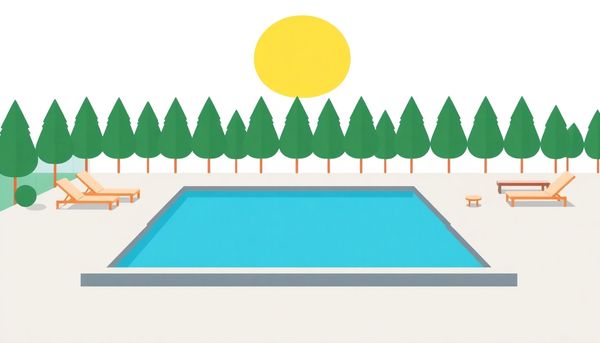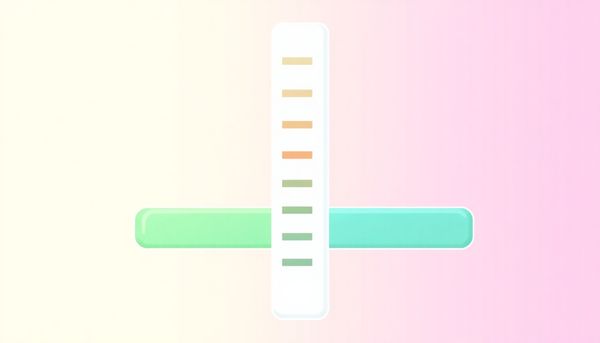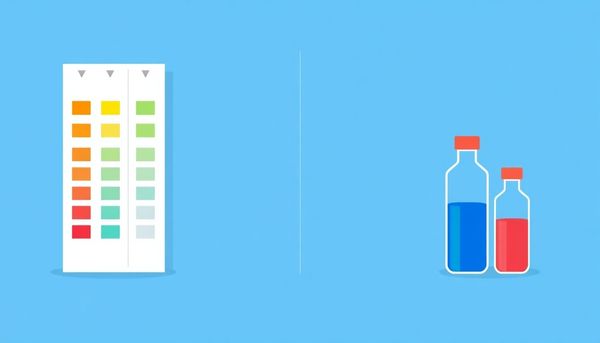Master Pool Water Chemistry with Test Strips: A Complete Guide
June 16th, 2024
June 16th, 2024
On a sweltering summer afternoon, nothing beats the allure of a sparkling, inviting pool. Yet, maintaining that idyllic oasis requires more than just occasional skimming. The secret lies in understanding the nuanced chemistry of your pool water. Enter pool test strips, those slender, colorful indicators that hold the key to balanced pH, appropriate chlorine levels, and more.
When I first inherited the responsibility of pool maintenance, I recall staring at the strip of paper, bewildered by its potential to reveal so much. The magic of these strips lies in their simplicity and accuracy. With a quick dip, they transform, revealing a spectrum of hues that inform you about the unseen world beneath the water’s surface.
Each pool, like a fingerprint, has its own unique needs. Factors such as recent rain, heavy usage, or even nearby flora can influence water chemistry. My neighbor once chronicled her struggle with algae, not realizing her pool’s pH was akin to lemonade's. With the right use of test strips, such mysteries unravel effortlessly, ensuring your pool remains a safe haven rather than a breeding ground for unpleasant surprises.
In this guide, we will explore the art of using these test strips correctly, ensuring that your pool remains a crystal-clear gem and a source of endless enjoyment. Whether you're a novice or a seasoned pool owner, mastering this skill is pivotal to a seamless swimming season.

Testing pool water might seem straightforward, but mastering it ensures your swimming haven remains inviting and safe. Regularly testing is vital, as it alerts you to any chemical imbalances that could affect water quality. Think of pool test strips as your trusty sidekick—nimble and efficient, allowing you to quickly assess total hardness, chlorine levels, pH balance, and other critical parameters in mere seconds. These test strips are the unsung heroes of pool maintenance, easily accessible yet packed with the ability to pinpoint potential issues before they escalate.
A few years back, when I first dipped my toes into pool ownership, I underestimated the importance of consistent testing. One summer, after a particularly harsh storm, I noticed the water turning cloudy. A quick test revealed that the balance was off due to an influx of contaminants. Since then, I've learned to make testing a weekly ritual, especially after unusual weather events. It's fascinating how a simple strip can reveal so much about your pool’s health.
Preparation is key. Before dipping that strip, ensure your pool pump has been running for at least an hour, circulating the water thoroughly. Collect your sample from elbow depth to avoid surface pollutants, then swiftly compare the strip to its color chart. This will guide your next steps in adjusting chemical levels to optimal ranges. Remember, the broader your testing coverage, the clearer your pool’s picture becomes. For a deeper dive into pool chemistry, our Basic Pool Chemistry 101 guide can offer additional insights.
Mastering the art of pool-test strip techniques can transform your pool maintenance routine from stressful guesswork into a straightforward process. Begin by ensuring your pool’s circulation system is running optimally; this primes the water for accurate testing. An hour of vigorous circulation should do the trick. Then, with a clean glass cup, immerse your arm into the pool up to your elbow to collect a true representation of your water quality. Avoid scooping from the surface or anywhere near chemical dispensers, as these areas can skew results.
With your sample ready, dip the test strip quickly into the water and remove it right away. No need to linger; a swift action ensures the most precise reading. Allow the strip to air for about 15 seconds. This wait time is crucial, as it ensures the colors fully develop without interference from shaking or external moisture.
Now comes the fun part: match your strip to the color chart on the packaging. Each hue corresponds to specific chemical levels, guiding you on what adjustments are necessary. Pool test strips are indispensable for tracking crucial chemical metrics such as pH and chlorine levels. However, keep them dry and stored away from sunlight to preserve their integrity.
Embrace the simplicity of test strips as a regular part of your pool care toolkit. They offer a cost-effective, reliable snapshot of your pool’s health, ensuring you can enjoy crystal-clear water without the hassle.
Balancing your pool’s water chemistry might seem as complex as a chemistry class you once dreaded, but it's vital for maintaining a safe and sparkling oasis. Test strips, those handy little tools, can make this task much less daunting. They deliver quick readings on your water's chemical levels, including pH, alkalinity, and sanitizers like chlorine and bromine. It’s not just about splashing around; understanding what these readings mean can save you from a host of problems down the line.
Start by diving into the details of each parameter. For instance, pH levels should hover between 7.4 and 7.6. If they stray too far from this range, the water might irritate skin or damage pool equipment. Alkalinity, acting as a buffer, should stay between 80 and 120 ppm to prevent rapid pH shifts. Meanwhile, sanitizer levels, crucial for keeping your pool free from harmful bacteria, need regular monitoring and adjustment.
Remember, a balanced pool isn't just about numbers; it’s also about preventing issues like cloudy water or algae blooms. Once you master the art of testing and adjusting, you’ll notice fewer headaches and reduced costs on unnecessary chemicals. Keep those strips fresh and dry, and consult professional help when unsure. Soon, you'll manage your pool like a seasoned pro, ensuring it's ready for endless summer fun.
When it comes to testing pool water, the choice between test strips and liquid kits can feel like comparing apples and oranges; both have their place in the toolbox, but serve slightly different purposes. Test strips bring convenience to the forefront, offering a swift snapshot of your pool's vital statistics—think pH, chlorine, and alkalinity. They're the go-to solution for pool owners who want quick answers and are easy to store, provided they remain dry and away from sunlight. Yet, their simplicity can sometimes mean sacrificing precision, especially if the strips have expired or been improperly stored.
On the other hand, liquid test kits are favored by those seeking precision. These kits allow for a more detailed analysis, beneficial when diagnosing more complex pool chemistry issues. However, with great accuracy comes a steeper learning curve and a higher cost. Each test involves careful measurement and mixing, leaving plenty of room for user error. Despite these downsides, they are indispensable when analyzing less common chemical levels that test strips might not cover.
Ultimately, your choice depends on your needs. For everyday maintenance, test strips suffice. But for a detailed chemical analysis, especially when facing persistent clarity issues, a liquid test kit is worth the investment. Balancing ease of use with the need for accuracy is the key to effective pool water testing.

There's a certain satisfaction in stepping into a pool with sparkling, perfectly balanced water. Achieving this ideal state hinges heavily on your ability to maintain an optimal pool-chemical balance. A pool that’s too acidic or too alkaline can not only cause discomfort but may also damage your pool equipment and surface. Testing strips serve as your first line of defense in avoiding these pitfalls, offering a quick glance at your pool's chemical state.
When you test your pool water weekly, you're setting the stage for proactive pool care. For instance, imagine a warm summer week when your family uses the pool daily. This increased activity, combined with higher temperatures, can significantly alter your pool's pH and chlorine levels. By using test strips, you can quickly identify and address these changes. Simply dip the strip, wait a few seconds, and compare the colors. It’s straightforward, but don’t be fooled by its simplicity—this small step powers your pool’s health.
However, test strips are only as effective as their storage conditions. Keep them dry and away from direct sunlight to preserve their reliability. It’s easy to neglect these tiny details, but maintaining their integrity ensures you’re not misled by erroneous readings. Ultimately, a well-balanced pool environment isn’t just about convenience; it’s a commitment to safety and enjoyment for everyone who takes a swim.
Mastering pool-testing techniques requires a blend of precision, timing, and a touch of routine. Before you even reach for those test strips, make sure your pool's pump has been running for at least an hour. This ensures the water is well-circulated, offering a more accurate snapshot of your pool’s chemistry. I remember a time when I tested my pool without turning on the pump—let's just say, the results were as inconsistent as a toddler's mood swings.
Gathering your water sample is an art in itself. Use a clean glass cup and dip it elbow-deep into the water, steering clear of surface ripples and chemical dispensers. This avoids skewed results from chemicals that haven’t yet dispersed properly. Once you have your sample, it's time for the test strip to shine. A quick dip and immediate removal is all it takes—no need for a prolonged soak.
After a 15-second pause, match the strip to the color chart on the packaging. This color comparison is your key to unlocking what adjustments your pool might need. Regular use of pool test strips provides a convenient and cost-effective way to monitor your pool’s health. However, be cautious; exposure to moisture or sunlight can spoil an entire pack. Always store them in a dry, cool place to ensure longevity. For more intricate chemical assessments, liquid test kits can complement your routine, offering detailed insights for those trickier situations.
Selecting the right method for testing pool water can feel like navigating a maze with many paths. Each choice has its own set of advantages and limitations, but understanding your specific needs will light the way. For those who prioritize speed and convenience, pool test strips are indispensable. They provide quick insights into essential metrics like pH, alkalinity, and chlorine levels. I remember my neighbor swearing by them, especially during a busy summer when their kids were in and out of the pool all day. They appreciated not having to spend much time on testing while still keeping the water safe.
On the other hand, if precision is your top priority, liquid test kits might be your go-to option. These kits, though more intricate to use, offer a degree of accuracy that test strips might lack. They’re particularly useful if you need to monitor a wide range of chemicals. A friend of mine, a stickler for detail, prefers using these kits, especially after heavy rainstorms when the pool’s chemical balance can become quite unpredictable.
Ultimately, the choice between test strips and liquid kits often boils down to what you value more: the convenience of test strips or the detailed accuracy of liquid kits. Whichever you opt for, keeping a regular testing schedule ensures that your pool remains a sparkling oasis, ready for enjoyment.
Maintaining the perfect chemical balance in your pool is akin to keeping a fine-tuned orchestra in sync. Each component must harmonize to create a safe and sparkling swimming experience. Weekly testing is recommended, but if your pool water looks cloudy or you’ve just weathered a storm, an extra check won’t hurt. Unusual conditions can throw off balance faster than you might think.
Before you test, take a moment to prepare. Turn your pool pump on high and allow the water to circulate for at least an hour. This ensures you’re testing a representative sample rather than stagnant or unevenly mixed water. I remember once forgetting this step and was baffled by a wayward reading that had me panicking over phantom algae. Lesson learned!
For the best results, use a clean, glass cup to collect a sample from elbow-depth in the pool. This prevents skewing results with surface water or areas influenced by chemical dispensers. Dip your test strip in briefly, then hold it in the air for about 15 seconds. Compare the colors to the chart on the packaging to see where adjustments are needed.
Proper storage is crucial. Keep your strips dry and shielded from light to avoid rendering them ineffective. And remember, if you ever question the accuracy of your test results, taking a sample to your local pool store can provide clarity. Through consistent and precise testing, you’ll ensure your pool remains a pristine oasis all season long, free from unwelcome surprises.

Ever found yourself squinting at a pool test strip, wondering if that shade of blue is more sky or navy? It's a common dilemma, but mastering the art of using these strips can save you from future guesswork. First things first: ensure your pool water is well-circulated. An hour of high-speed pump action will mix everything properly, giving you a true snapshot of your water’s chemistry.
When you’re ready, grab a clean glass cup—not just any old cup. This ensures that residue from past uses doesn’t taint your sample. Reach elbow-deep into the pool, steering clear of surface water, which might be skewed by chemicals floating on top. A quick dip of the strip is all it takes, no soaking required. Those fifteen seconds while you wait for the colors to develop might feel interminable, but patience is key. Hold the strip steady, no shaking allowed, and compare it alongside the color chart on the packaging.
Remember, test strips are your allies in the battle for balanced water, but they have their weaknesses. Moisture and sunlight are their arch-nemeses, so store them in a cool, dry place. Keep an eye on expiration dates too; expired strips can send you on a wild goose chase with inaccurate readings. With practice and precision, you’ll soon read these strips like a pro, keeping your pool pristine with minimal fuss.
The art of sampling pool water holds the key to accurate chemical readings. Whether you've just installed a new swimming oasis or maintained one for years, mastering this step can prevent countless headaches. Start by switching on your pool pump, cranking it to high, and letting the water swirl for at least an hour. This ensures an even chemical distribution, avoiding skewed results from static zones.
Next, grab a clean, non-metallic container—preferably glass—to collect your sample. Instead of skimming off the top, dive your arm elbow-deep into the water, steering clear of surface skims or areas near chemical feeders and pool returns. These regions often contain higher concentrations of chemicals not reflective of the entire pool's balance.
With the sample in hand, dip a test strip into the water for a mere second, then pull it out. Resist the temptation to shake it like a Polaroid photo; this can distort the results. Instead, let it sit in the air for 15 seconds. During this time, the strip's colors will develop, revealing your pool's chemical secrets.
Once the palette has settled, compare the strip to the color chart on the packaging. This is your roadmap to understanding which chemicals need adjustment. Regular practice of this routine should become second nature, like brewing morning coffee, ensuring pool water remains pristine and inviting. For those feeling uncertain, remember there's plenty of guidance available to demystify pool chemistry further.
When it comes to ensuring your pool's health and clarity, handling test strips correctly can make all the difference. Treat them like a delicate tool, for that's precisely what they are. One day, I learned this the hard way after leaving a pack near my poolside, only to find they had turned useless in the midday sun. Protecting your strips from moisture and UV damage is paramount; always keep them sealed and stored in a cool, dry place.
Before you begin testing, prepare the environment. Let the pool’s pump run for an hour to ensure the water is fully circulated. This step is crucial to avoid misleading readings from stagnant or stratified water layers. Once your water is ready, extend your arm elbow-deep into the pool, bypassing surface contaminants and chemical hotspots near dispensers, to gather your sample. This ensures a representative portion of water for accurate testing.
When it comes to the act of testing, practice patience. Dip a strip quickly in and out, resisting the urge to shake off excess water. As the seconds tick by, watch as the colors develop; a small moment of chemistry right in your hand. Align the strip with the color chart while the hues are still fresh. Interpretation soon follows, guiding your next steps in balancing the pool's chemistry.
Remember, proper handling isn’t just about getting the right readings today; it’s about ensuring the longevity and reliability of your test strips tomorrow. So, treat them with the care they deserve, and they’ll help keep your pool sparkling clean.
When juggling the demands of pool maintenance, choosing between test strips and liquid kits can feel like selecting between efficiency and precision. On one hand, test strips offer the speed and convenience akin to grabbing a quick coffee on a busy morning. With a swift dip, they provide insights into vital parameters like pH, chlorine, and alkalinity. Their affordability and ease of use make them a popular choice for weekly checks. However, they come with their own set of caveats. Exposure to moisture or sunlight can render them ineffective, and they expire, sometimes without notice.
Conversely, liquid test kits resemble the more meticulous ritual of brewing a perfect cup of tea. They demand patience and a bit of practice but reward you with a level of precision that's hard to match. These kits can test a wider range of chemicals, crucial for detailed water analysis, and are particularly advantageous when dealing with complex issues like metal content. However, the trade-off includes a higher cost and the potential for user error, given the multi-step process involved. The reagents also have a shelf life, necessitating periodic replacement to maintain accuracy.
In the end, the choice hinges on your needs and routine. For quick, regular checks, test strips are invaluable. But when precision matters, especially in tackling stubborn water quality issues, reaching for a liquid kit might be the better call.

Testing pool water can feel like learning a new language—one filled with colors and numbers. Yet, even a slight misstep can lead to cloudy water or worse. Let’s explore some common testing mistakes and how to dodge them.
First, ensure the test strips remain dry until use. Leaving them exposed to humidity, sunlight, or even a slightly damp storage spot can throw off results. A friend once kept hers in a garden shed—big mistake! They absorbed moisture and registered inaccurate readings.
Timing when you test is another critical factor. Morning tests might skew the results due to overnight chemical changes. I learned this the hard way after a stormy night, which diluted my pool overnight. Always wait at least an hour after adding chemicals or a heavy rain before testing. This allows the water to stabilize and circulate properly.
Another frequent blunder is mishandling the strip during testing. Dipping it too long or shaking it off disrupts the chemical reaction needed for accurate readings. Simply dipping and holding it steady is enough. This isn’t a polaroid; it doesn’t need a shake!
Lastly, pay attention to expiration dates. Expired strips can lead to questionable results, much like using expired milk in your morning coffee—something you immediately regret. Checking these details ensures your pool stays pristine and inviting. With these tips, you’ll be well-equipped to avoid these common pitfalls and keep your pool in top shape.
Imagine stepping into a crystal-clear pool on a hot day, only to discover that things aren’t as pristine as they seem. Ensuring accurate sample collection is the first step to keeping your pool water inviting and safe. Before you even think about dipping a test strip, it's crucial to prepare the water properly. Start by turning the pool pump on high, allowing the water to circulate for at least an hour. This helps distribute any chemicals evenly, avoiding misleading results from stagnant water.
Next comes the art of sample collection. Grab a clean glass container and extend your arm elbow-deep into the pool, steering clear of skimming the surface. Surface water often contains oils or other residues that could skew your readings. Avoid areas near chemical dispensers or pool returns, as these spots might have concentrated levels of specific chemicals, giving you a false sense of security about your pool’s overall balance.
Once you have your sample, it's time for the test strip to do its magic. Dip the strip swiftly into the water and pull it out just as quickly. Holding it steady for about 15 seconds is key; shaking it can distort the results. Afterward, compare the strip to the color chart on the packaging. This step helps pinpoint what needs adjusting to maintain a healthy swimming environment.
Finally, remember that the environment around your test strips matters. Store them in a cool, dry place to prevent dampness or sunlight from affecting their accuracy. With these steps, you're well on your way to mastering pool maintenance with precision and ease.
Selecting the perfect test-kit for your pool might seem like navigating a maze, but it’s the compass that ensures your oasis remains crystal clear. Different kits cater to specific needs, so understanding your pool’s quirks is key. For instance, if you're a weekend warrior who thrives on simplicity, test strips are your best friend. They cover essential chemistry checks—pH, chlorine levels, alkalinity, and even cyanuric acid—in mere seconds. Their ease of use and affordability make them a staple for quick, routine checks. However, beware of their foes: moisture and sunlight, which can render them useless.
For those who fancy themselves as budding chemists or have pools prone to complex issues, liquid test kits offer a more detailed analysis. They allow for a deeper dive into your pool’s chemical balance, providing more precise readings, especially useful for those battling persistent algae blooms or unusual water conditions. The trade-off? They demand more time, skill, and a slightly heftier budget.
If saltwater is your pool’s essence, look into specialty strips capable of detecting salt levels alongside metals like copper and iron. Always have a backup plan—when test results are puzzling, take a sample to your local pool store for a professional check. Choosing wisely between strips and kits sets the stage for a trouble-free swimming season, letting you focus on enjoying your pool rather than managing it.
Ensuring your pool test strips deliver accurate results hinges significantly on how they're stored. A few summers back, I learned this lesson the hard way. I left my test strips carelessly on a sunlit table, only to find them faded and unusable when I needed them the most. To avoid such frustrations, it’s crucial to store them correctly.
Start by keeping your test strips in their original container with the lid tightly sealed. This prevents exposure to moisture, which can render them ineffective. Humidity is the enemy here, so it’s best to store them in a cool, dry place—your pool shed or a kitchen drawer works well, as long as they’re away from potential water exposure.
It’s also important to check the expiration date. Much like milk, expired test strips can’t be trusted for accuracy. When purchasing, aim for the freshest batch available and avoid stocking up too much at once. Over the years, I've found it helpful to mark the purchase date on the container, ensuring I always use the newest first.
Finally, remember to handle them with clean, dry hands. Even a slight transfer of moisture or residue from your fingers can skew the results. With these mindful practices, your test strips will remain a trusty ally in keeping your pool water crystal clear and perfectly balanced.

When maintaining a pool, both test strips and liquid test kits serve as essential tools in your water-testing arsenal. Think of test strips as the fast-food option of pool testing. They offer a quick and efficient snapshot of your pool's health. With just a dip, you can check levels of total hardness, chlorine, bromine, pH, alkalinity, and cyanuric acid in a matter of seconds. For anyone needing frequent checks, especially during warmer months or after a storm, these strips are invaluable. However, their convenience comes with a caveat: exposure to moisture or sunlight can spoil them, and they do have a shelf life.
On the other hand, liquid test kits are akin to a gourmet meal. They demand more time and attention but reward you with precision. These kits delve deeper into chemical levels, offering a wider range of tests. Yet, the increased complexity can lead to user error, and the initial cost is steeper. Additionally, the chemical reagents need periodic replacement to ensure accuracy.
In essence, each method has its merits. If you’re juggling a busy schedule and need a quick appraisal, test strips might be your best bet. But if accuracy is paramount, especially when troubleshooting specific issues, investing in a liquid test kit could be the way to go. It's about balancing your need for speed with the desire for detail.
Navigating the realm of pool maintenance often begins with choosing the correct testing method. When it comes to pool test strips, these handy tools can offer a glimpse into your pool's chemical balance, making them indispensable for regular upkeep. Remember, not all test strips are created equal. Selecting the right type can significantly impact your pool care routine.
Start by identifying what you need to test. Standard strips measure essential parameters like pH, chlorine, and total alkalinity, giving you a snapshot of your pool's health. However, if your pool has specific issues, such as metal contamination or high salt levels, specialty strips are available. They allow you to tailor your testing to the unique demands of your pool environment.
Take into account the frequency of testing and external conditions. During warmer months or after heavy rains, your pool's chemical balance might shift, necessitating more frequent checks. Test strips are quick and straightforward, perfect for weekly assessments. In contrast, liquid test kits, while more intricate and accurate, can be cumbersome for regular use but are ideal for in-depth analysis when precision is paramount.
Storage also plays a crucial role. Keep your test strips dry, away from sunlight, and be mindful of expiration dates to avoid skewed results. Consider combining test strips with periodic professional testing for a comprehensive approach. By carefully choosing and maintaining your testing tools, you'll ensure your pool remains a safe and inviting haven throughout the swimming season.
Precision in pool water testing isn't merely about dipping a strip and waiting for colors to change. It's a meticulous process where each step plays a crucial role in ensuring your pool remains a haven of clear, balanced waters. As someone who has faced the frustration of misleading results, I’ve learned that accuracy begins long before the strip meets the water.
First, always ensure the water has been circulating for at least an hour by setting your pump on high. This guarantees the sample you collect reflects the true state of your pool. Once, after a particularly intense storm, I skipped this step and ended up with skewed readings that led to overcorrecting my chemical levels. Lesson learned—stagnant water tells a confusing tale.
Next, use a clean, non-reactive glass cup to collect water from elbow depth. Avoid skimming the surface or gathering near chemical dispensers—such spots often hold concentrated chemicals that don’t represent the pool's overall chemistry. I once made the mistake of swirling my strip directly in the pool. A quick dip and removal is all that’s needed, as prolonged exposure can saturate the strip and distort the results.
After dipping, hold the strip steady—no shaking—to let the colors develop. Compare promptly to the color chart on the packaging, which is your key to understanding which chemicals need adjustment. Keep your strips dry and cool to prevent premature aging, as moisture can render an entire batch unusable.
Remember, for in-depth testing or when results seem erratic, consider heading to a pool store for more comprehensive analysis. Balancing your pool’s chemistry not only saves time and money but ensures a refreshing swim every time.

This article provided insights into maintaining your pool. Start your pool care journey today!
Want to become a pool maintenance expert? Our free Pool School course covers everything you need to know about pool care. From basic maintenance to advanced troubleshooting, you'll learn how to:
Join over 10,000 pool owners who have already transformed their pool care routine. Get started with our free Pool School course today!